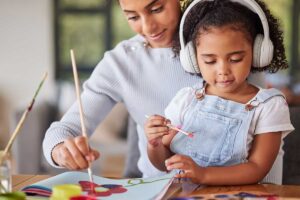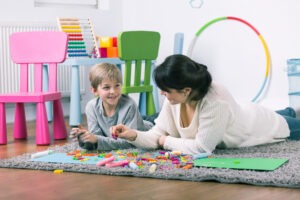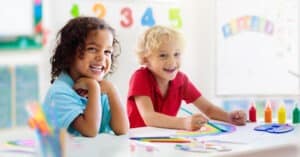As part of our speech and language milestone series, we’ve highlighted the speech milestones you can expect to see from your three-year-old:
1. Intelligibility: how much of your child's should a listener be able to understand?
A 3-year-old should be approximately 75% intelligible to an unfamiliar listener. This means that you should be able to understand about 75% of what your child says. As their parent, you are an expert in interpreting your own child’s speech. To obtain an unbiased assessment of your child’s intelligibility we recommend asking a grandparent, teacher or friend: “How much of ____’s speech can you understand?”
If you notice that your child speaks fast or seems to mush words together, working on your child’s rate of speech can be helpful. If your child does not yet understand the concepts of fast vs. slow, you can use animals to teach these concepts. For example, talk about how cheetahs and bunnies run fast while turtles and snails move slowly. Modeling a slower rate of speech can be very helpful for children this age. Also, try not to interrupt so you give your child plenty of time to respond.
If your child drops the final sound in works (e.g. pi/pig, ho/hot, foo/food) or is not using the following consonant sounds (m, p, b, t, d, n, h, w, k, g, f), please don’t hesitate to reach out to TherapyWorks for a consult. We’d be happy to discuss your child’s speech and make recommendations for home practice.
2. Answering questions: who, what, where, why
At age three, children are learning to answer questions that are less and less concrete. These include “who, where, why” and “how” questions. Visual support, such as pictures, can be beneficial for children when learning to answer more complex questions. Ask your child questions while you read picture books. If your child struggles to answer the question, give him/her two choices. For example, if the question is, “Where do you buy food?”, you cue them with the following choices, “At the grocery store or at the library?” Asking complex questions while recapping your day is also a great idea. If you take pictures on your phone, you may want to use these pictures for additional support. As you start to work on answering more complex questions, pay attention to which types of questions are the most difficult for your child. It can be helpful to work on one type of question at a time.
3. Expanding Sentences
Three-year-olds communicate using sentences. At this age, a child typically uses around 1,000 words. You can help your child develop their expressive language skills by adding one or two words or word phrases onto what they say. For example, if your child says “truck” you may model, “Yes! That’s a truck. That’s a big, red truck.” Children’s grammatical skills dramatically improve at age three. Here are some of the grammar milestone you can expect before your child’s 4th birthday:
- -ing in the present tense (i.e. going)
- “in” and “on” are used in everyday speech
- plural -s
- irregular past tense verbs (i.e. fell and went)
- possessive -s (i.e. mom’s shoes)
If your child is not yet applying these rules of grammar, modeling them in your own speech can be very helpful. For example when teaching plural -s, exaggerating the “s” sound at the end of the word. Children naturally pick up on rules of grammar by engaging in simple conversations with others. Simply talking to your child and giving them time to respond will positively influence their ability to express their thoughts and ideas to the world.
4. Receptive language
You can improve your child’s receptive language skills, or ability to understand the spoken language of others, by playing games that involve following directions. Try to incorporate new concepts when possible. For example, you may want to try adding spatial concepts such as “between” or “next to.” You can also continue to improve your child’s receptive language by reading new books about different topics. If your child has a favorite, reading the same book over and over is no problem. That said, try to add in new books when you can to expose your child to new words! You might try reading one new book and one old book at bedtime. Activities that involve sequencing are also great for developing receptive language.
5. Social Language
Promote social language skills by scheduling play dates or going to the park or a community play space. Since most 3-year-olds are engaging in associative play, you can find toys that both children have and have them play with the toys at the same time. Perhaps each child brings his/her own wooden blocks, Legos or play-dough. Remember, associative play means that children play the same game but they do not work together or connect with one another. A child may be interested in engaging with another child but still needs a little help. You can encourage your child to interact by commenting and asking questions (“Did you see that ___ is playing with the blocks? You could ask if he wants to make a tower with you.”)
If you have any specific questions about your child’s three-year-old milestones (or anything else), please reach out to TherapyWorks.




